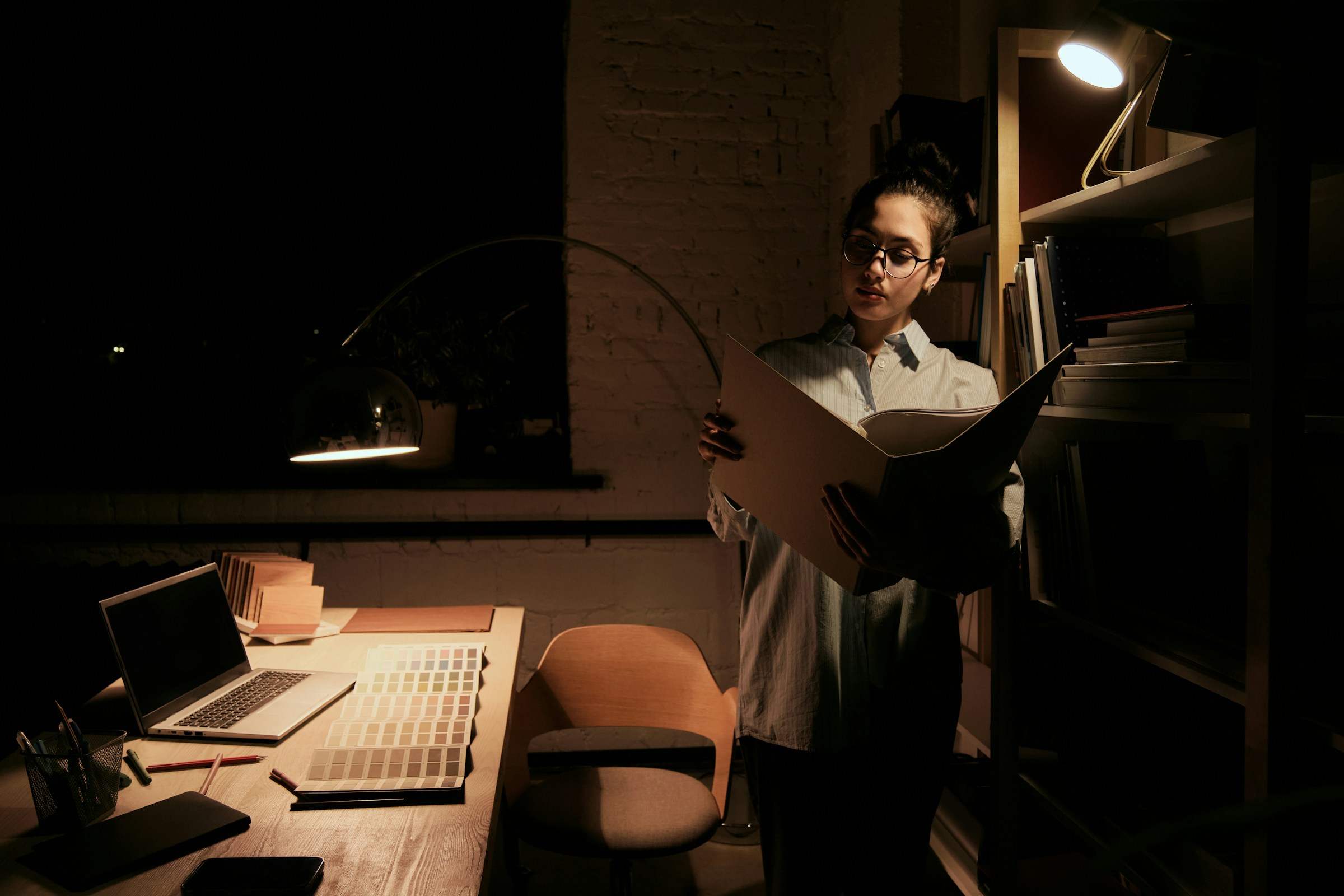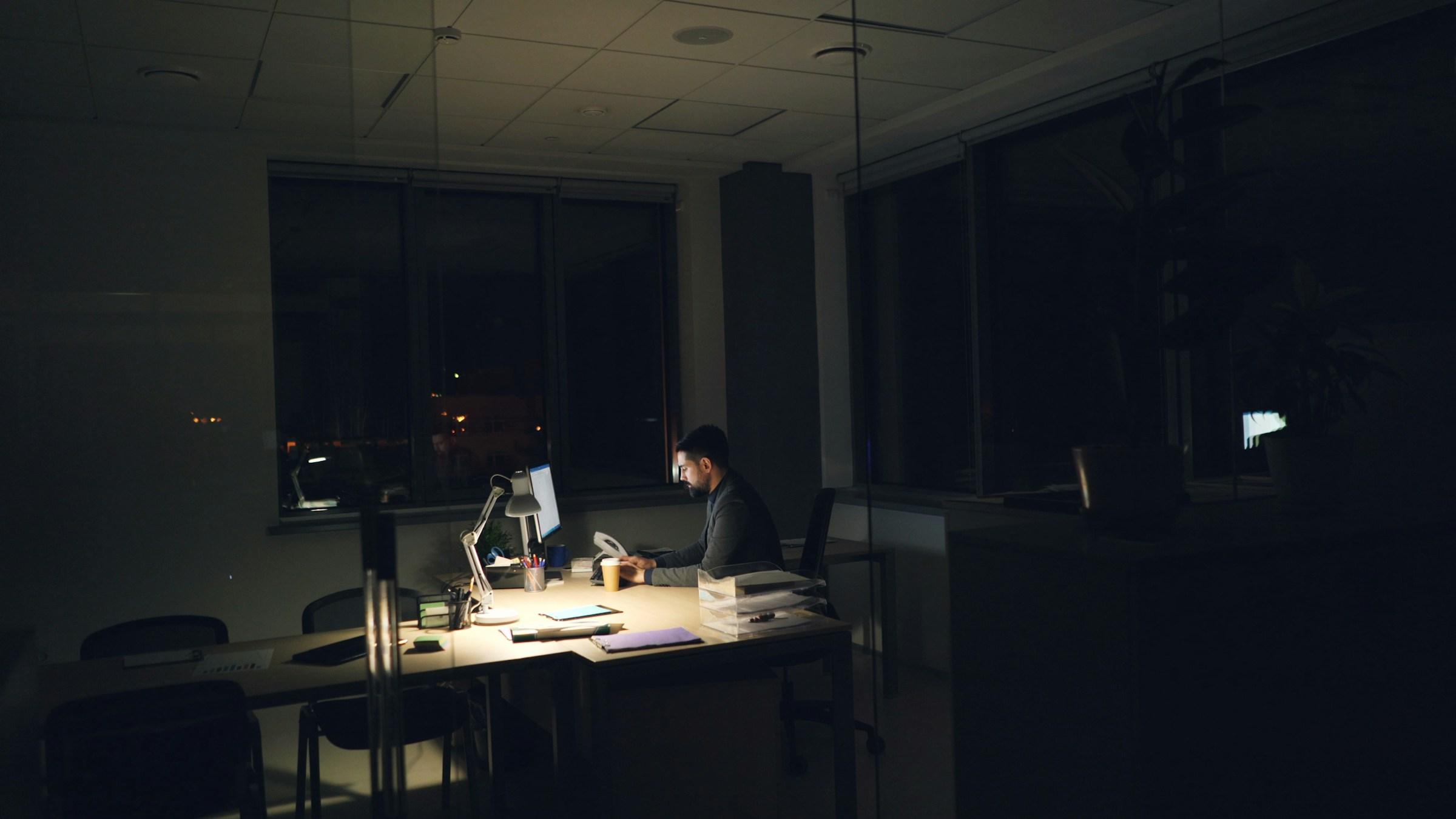Working in the dark is not an aesthetic preference, it is a practical choice about inputs. Light is an input, noise is an input, and attention is a limited resource that breaks when the wrong inputs pile up. When you remove the wrong inputs, the system runs cleaner. Brightness pulls at your eyes, screens glow, walls reflect, and every reflective surface competes for the same mental bandwidth you need for serious work. When you reduce luminance, the competition falls away. What remains is the task and the time you give it, and from that pairing a quiet, durable focus begins to form.
Darkness reduces visual noise. You see fewer details, so your brain guesses less. Working memory stops buffering irrelevant edges, reflections, and movements on the periphery. That freed capacity becomes available for reasoning, language, and problem solving. The benefit feels small moment to moment, but it compounds across an hour and across a workday, which is exactly the kind of compounding that produces chapters drafted, models debugged, and briefs finished rather than postponed.
There is a biochemical layer to this choice. Light that strikes the retina sends daytime signals through the brain and the body. Strong light can create a sharp alerting effect that sounds helpful, yet it often comes with spikes and dips that nudge you toward stimulation seeking and away from steady concentration. Dimmer, warmer light can support a more even arousal state without the jitter, which makes caffeine feel cleaner and makes pacing more predictable. You are not trying to wind yourself up and then crash. You are shaping a stable lane where attention can hold for the length of a deep work block.
Glare is another quiet enemy. It rarely registers as pain. It registers as subtle discomfort, more blinking, more squinting, and a need to re aim your gaze that you only notice when you reread a line for the third time. In darkness, or in a room with carefully controlled light, glare recedes. Your eyes track text rather than reflections, and tracking beats fighting.
Darkness is also a social filter. Bright spaces invite signaling. We perform small rituals of posture, expression, and micro grooming when we feel observed, even if no one is watching. Those cycles consume attention. In low light those demands fall silent. You stop performing for the room and return to performing for the work. Self interruption declines, and small decisions that normally sap momentum simply do not arise.
Creative work often thrives on constraint, and darkness is a clean constraint. Fewer cues greet you, fewer branches tempt you, so your mind fills gaps with association and pattern. Many people find that first drafts come easier in dim light, while editing benefits from brighter conditions that reveal errors and inconsistencies. Draft in low noise and edit in high clarity is a split that works for many fields, from writing to design to code.
Sleep matters in this equation, especially for anyone who works at night. Bright light late in the evening pushes melatonin back and shifts sleep later, which degrades recovery and mood across the week. Working in the dark, or with very low warm light, lets you finish an evening block without convincing your circadian system that midnight is morning. If you need task lighting, keep it warm, indirect, and as low as readability allows.
There are posture and tension dividends as well. In a dim room you stop scanning for motion. Shoulder load reduces, neck tension eases, and breathing becomes slower and deeper. Lower physical tension supports endurance on cognitively complex tasks. The goal is not to grind but to maintain precision across a full block without feeling cooked at the end.
All of this becomes more powerful when treated as protocol rather than vibe. Turn off overhead lights that produce hard reflections. Close or dim lamps that bounce on your screen or your desk. If daylight spills across your field of view, use curtains, a shade, or a slight shift in desk angle to control it. Set your display to dark mode and lower brightness until text is readable without strain. The number will look too low at first, and your eyes will adapt in a few minutes. Increase font size and line spacing rather than leaning toward the screen. Keep the display about an arm’s length away. If your eyes ache or a headache starts, the room is too dark for the current task, so dial brightness up slightly and take a longer recovery between blocks.
Sound belongs to the same ecosystem. Reduce it or keep it steady. If silence is not possible, use a fan or brown noise rather than music with vocals. Language in your ears competes with language in your head. Your audio should not commandeer the same circuits the task requires. Devices leak both light and attention. Place your phone face down and out of reach. Use a single screen when possible. If you must use two, stack them so your head does not swing left and right every minute. Head swings are focus leaks, and leaks add up. Make the primary screen the only bright plane in your view.
Choose tasks that fit the setting. Analysis, drafting, reading dense material, data exploration, and code review benefit from monotask and low sensory load. Meetings do not. Conversations need facial cues, energy, and nonverbal signals, which bright light supports. Match the environment to the job rather than forcing one mode to do everything.
Time the block like an athlete times a set. Start with fifty minutes and leave the room wanting more. Advance to seventy five or ninety when it feels natural. End the block with a light reset. Step into brighter light for a few minutes, look at a distant point to relax the focusing muscles, move your body, and drink some water. That reset helps your eyes and tells your clock that the day still exists. Then either commit to a second dark block or switch to normal work.
Cravings to break the block will appear. You will want to check messages, nudge a lamp, or open a new tab. Label the urge on a sticky note, return to the sentence or the function you were in, and finish that unit. Reward comes after the block. The rule matters more than the mood, and integrity to the rule is what turns an experiment into a habit.
Dark work is not a full day plan. It is a precision tool. Use it once or twice daily, perhaps three times on heavy days. Morning blocks help people with noisy homes or open offices. Post lunch blocks help those who crash in the early afternoon. Evening blocks help night owls who still want to protect sleep. Pick one slot, test for a week, and let results rather than feelings guide the next decision.
There are caveats. Some people do not respond well to extended low light. If you have seasonal mood issues, be careful. Morning exposure to bright outdoor light for at least twenty minutes should remain a baseline. Dark work is a supplement to daylight, not a replacement. Start with small doses, observe mood and sleep, and adjust the balance.
Team context matters. In shared spaces, use a clear signal for deep work so colleagues know when not to tap you on the shoulder. A small warm lamp on the desk, paired with a status line in chat and a stated comeback time, preserves trust and reduces friction. Protocols that respect others last longer. The physical setup can help. Matte surfaces beat glossy surfaces. A dark mouse pad and a non reflective desk reduce stray reflections. A simple cardboard hood on the monitor can block light from behind you. None of this requires new gear. You are removing friction, not chasing gadgets.
Software design should support the same goal. Use distraction free modes, hide toolbars, stretch the active window to fill the screen, and turn off notifications. Batch your inputs between blocks. People like to describe this as discipline. It is better to think of it as architecture. Build your environment so that the default choice is the correct one and discipline becomes a lighter lift.
The mental pattern behind all of this is simple. Darkness is a constraint that drives depth. Depth is easier to choose when the environment removes unnecessary options. You are not chasing motivation. You are removing alternatives. The brain translates that narrower corridor into momentum, and momentum is the true advantage because it carries you through the hard middle of a project where outcomes are won or lost.
Close the loop with recovery and labeling. After a dark block, step into light, roll your shoulders, breathe slowly, and then describe your progress in one sentence. Done or not done. Clear or unclear. Start the next step only after you name the state of the work. That small ritual stops drift and protects continuity between sessions. Over time you can stack complementary rules. Keep only task relevant tabs open. Keep the phone locked during the block. Do not edit while drafting. Make one pass for structure and a later pass for polish. Simple rules travel well because they survive stress, travel days, and the messy reality of a busy life.
The benefits of working in the dark are not mystical. They are the sum of lower visual noise, less glare, steadier arousal, and cleaner rules. Each element offers a small edge. Together they produce calm attention and finished output. That is the metric that matters. Build your protocol, test it for seven days, and track only two numbers, minutes spent in dark blocks and units shipped. If the numbers climb without a hit to sleep or mood, keep going. If they fall, adjust light and timing. Precision is better than bravado, and the work will tell you what the right balance is.











-7.jpg&w=3840&q=75)


